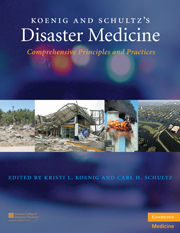Book contents
- Frontmatter
- Contents
- List of Contributors
- Contributor Biographies
- Foreword
- Preface
- Acknowledgments
- PART I CONCEPTUAL FRAMEWORK AND STRATEGIC OVERVIEW
- PART II OPERATIONAL ISSUES
- PART III CLINICAL MANAGEMENT
- SECTION A CBRNE AND HAZMAT
- SECTION B ENVIRONMENTAL EVENTS
- 32 Floods
- 33 Cyclones/Hurricanes/Typhoons
- 34 Tornadoes
- 35 Earthquakes
- 36 Tsunamis
- 37 Winter Storms
- 38 Extreme Heat Events
- 39 Volcanoes
- Index
- Plate section
- References
35 - Earthquakes
from SECTION B - ENVIRONMENTAL EVENTS
Published online by Cambridge University Press: 05 August 2011
- Frontmatter
- Contents
- List of Contributors
- Contributor Biographies
- Foreword
- Preface
- Acknowledgments
- PART I CONCEPTUAL FRAMEWORK AND STRATEGIC OVERVIEW
- PART II OPERATIONAL ISSUES
- PART III CLINICAL MANAGEMENT
- SECTION A CBRNE AND HAZMAT
- SECTION B ENVIRONMENTAL EVENTS
- 32 Floods
- 33 Cyclones/Hurricanes/Typhoons
- 34 Tornadoes
- 35 Earthquakes
- 36 Tsunamis
- 37 Winter Storms
- 38 Extreme Heat Events
- 39 Volcanoes
- Index
- Plate section
- References
Summary
OVERVIEW
Disasters have posed a significant threat to human lives and property throughout history. Such events include hurricanes, floods, tornadoes, tsunamis, and earthquakes, among others. During the past 40 years, disasters have caused more than 3 million deaths worldwide, including more than 1 million deaths from seismic events. Earthquakes are considered one of the most destructive disasters. An average of 16 earthquakes leading to death occur throughout the world each year with many more leading to injury and property damage. The Hanshin-Awaji earthquake in Japan produced at least 100 billion USD in damage and killed more than 6,000 people. The 1994 Northridge earthquake in California caused an estimated 20–30 billion USD in damages, and preliminary damage estimates for Hawaii's 2006 temblor reached 100 million USD. These events occurred in nations that have sophisticated, modern seismic building codes. Outcomes can be even more destructive in less developed countries (Table 35.1).
Society's continued vulnerability to the devastating effects of earthquakes is due to several factors. Earthquakes are within the category of sudden-impact disasters that strike quickly and without warning, making mitigation and evacuation efforts difficult. The quantity of property damage, loss of life, disruption of economic activity, and interference in the provision of important services associated with the effects of an earthquake vary depending on its magnitude and on the degree of earthquake preparedness and mitigation measures implemented in the region affected by the temblor.
Keywords
- Type
- Chapter
- Information
- Koenig and Schultz's Disaster MedicineComprehensive Principles and Practices, pp. 562 - 577Publisher: Cambridge University PressPrint publication year: 2009
References
- 1
- Cited by



